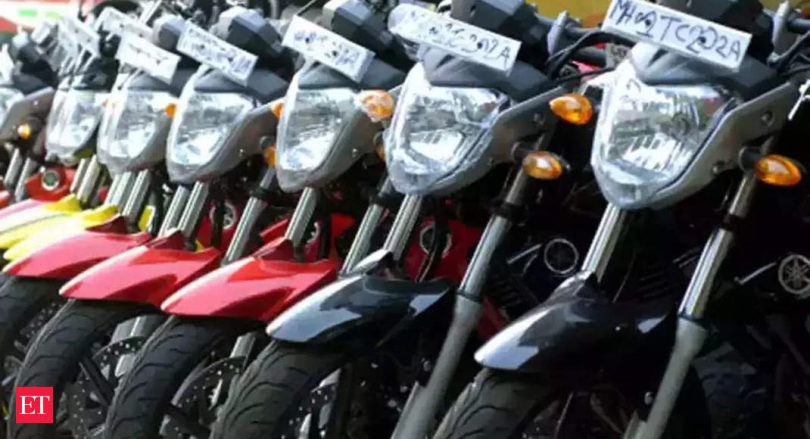[ad_1]
India, one of the biggest two-wheeler exporters globally, saw exports fall to 34.06 lakh units in April 2022-February 2023 from 40.9 lakh in April 2021-February 2022, a 16% drop, according to the Society of Indian Automobile Manufacturers (SIAM). In the case of three-wheelers, exports fell to 3.46 lakh units in April 2022-February 2023 from 4.61 lakh units in April 2021-February 2022, a 24% decline.
The reason is the economic crises in some of India’s biggest export markets for these vehicles. “The higher level of inflation is impacting consumption patterns in these countries, which has led to a pause in the demand of products such as two- and three-wheelers. Moreover, currency devaluation and falling affordability have led to postponement of purchases,” says Mitul Shah, head of research, Reliance Securities.
For most automobile companies, their overseas market footprint is in emerging and developing economies. India’s top markets for two-wheeler exports are Columbia, Nigeria, Philippines, Mexico and Nepal, while Nigeria, Somalia, UAE, Iraq and Mexico are among the top destinations for three-wheeler exports. Some of these countries are reeling from economic crises. If double-digit inflation, now spiralling past 20%, hit the Nigerian economy after the Covid-19 pandemic, demonetisation of the naira currency has dealt a body blow to it. Nepal had imposed a 10-month ban on imports, which in turn hit India’s auto exports. Ethiopia is in the middle of a drought and a brutal civil conflict, battling inflation of over 30% and facing foreign exchange shortages while Bangladesh has seen a depreciation of taka and a precipitation of economic woes.

Demand has become muted in these countries as imports have become more expensive because of a weaker currency. Adding to that is a shortage of dollars, which has dragged down India’s exports from the record highs two- and three-wheeler exports scaled in 2021.
“Exports account for almost 50% of the two-wheeler and three-wheeler sales of Bajaj Auto, which exports to over 90 countries,” says Rakesh Sharma, ED, Bajaj Auto. “While customers are adjusting to new and higher prices, availability of US dollars is still restricted for trading in many of these markets. It might take three-four months for some kind of equilibrium to be reached.”
Chennai-based T VS Motor Company recorded 7.54 lakh units of two-wheeler exports in the nine months ending December 2022, a fall of 7% y-o-y. Says Rahul Nayak, vice-president, international business, TVS Motor Company: “Despite this short-term degrowth, we remain optimistic about the long-term potential of these markets and are confident that normalcy will return in the coming months.” In January, two-wheeler exports of the company fell by 44% y-o-y to 48,239 units.

Vinod Aggarwal, president of SIAM, says some foreign banks are putting restrictions like a 100% cash margin for opening letters of credit (LoC) for auto imports, which is affecting India’s exports.Atsushi Ogata, MD of Honda Motorcycle & Scooter India (HMSI), says while there was a significant decline in its exports in the past six-eight months when shipment to countries like Bangladesh and Nepal dropped by almost 8-10% each, the company could tide over the crisis because of its stronghold in the Latin American market, where the Navi is the best-selling model, followed by Dio and XBlade. So it exported 332,304 units in FY22 compared with 2,09,789 units in FY21. HMSI exports 18 models to months, some kind of normalcy will prevail. We have leadership positions in markets like Nigeria. We have been quick to pare our stocks but we remain engaged with customers. When these markets return to normalcy, we expect to wrest a greater share of the recovery,” says Sharma.
TVS Motor exports products such as the HLX motorcycle, the Apache series of bikes and the TVS King three-wheeler to 80 countries. And Africa is its biggest export market.
Both Bajaj Auto and TVS Motor have captured the two-wheeler market share in Africa over the last few years at the expense of Chinese companies, say experts. Now many major markets in Africa are limiting the imports of vehicles and are focusing instead on the import of essential items although the demand for vehicles exists, says Rajesh Menon, director-general, SIAM.
Many two-wheeler companies are being forced to rework export strategies and enter newer markets such as New Zealand, Australia, Columbia and the Philippines.
TVS Motors is also exploring new opportunities and avenues for growth. “We believe that our strong focus on innovation, technology and quality will help us navigate through these challenges,” says Nayak.
Meanwhile, passenger vehicles are unaffected. In fact, their exports were 6.93 lakh units in April 2022-February 2023, a growth of 14% over April 2021-February 2022. Passenger vehicle exports, experts say, are not impacted as their markets are more widely dispersed and as they have a different customer profile.
Arun Malhotra, a Delhi-based automotive consultant, offers a way out of the crisis for two-wheeler companies. “The main motorcycle market will continue to perform poorly in many countries because of the economic crises there. However, the premium motorcycle segment is less impacted by that. The Indian two-wheeler companies need to focus on the upper end of the market,” he says.
SIA M is in the process of identifying a few markets to expand the footprint of automobile exports from India. It has started engaging with key stakeholders in these markets, including the respective Indian missions and relevant government departments.
Given t he macroeconomic uncertainties in a few markets, companies have reduced stocks with distributors. However, business rides on hope. The auto companies are optimistic that they can soon wheel out vehicles for export.
[ad_2]
Source link








